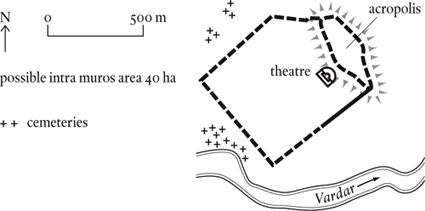
Macedonia
Classical Scupi, capital of the late Roman province of Dardania
Skopje is the key to the Vardar–Morava route connecting Macedonia with the Danubian lands. As such, its occupation (probably around 13 BC) was the necessary prelude to the Roman conquest of Moesia, a province that stretched along the right bank of the Danube from its midsection to its mouth. The native settlement that the Romans found at the site of Skopje took the form of a Thracian ‘oppidum’ on a hill overlooking the Vardar. The Roman town was built at the foot of the hill, probably utilizing the camp of the legion that spearheaded the advance into Moesia (tentatively identified as IV Scythica). A legionary camp was normally not much over twenty hectares, but Skopje town was considerably larger than this, probably twice the size. This was because it took in both camp and hilltop oppidum, the latter presumably as a sort of acropolis.

Skopje’s strategic position ensured that it retained its importance over time. It was the first town in Moesia to be given the status of a Roman colony (by Domitian c. AD 86), and when the province of Moesia Superior was divided in two, c. AD 300, it became the capital of the southern half, the province of Dardania (the Dardanians being the local Thracians). It probably became a garrison town again at this time, for there was a regiment of ‘Scupenses’ in the Roman army list of the late fourth century.
The fifth century saw the end of Roman Skopje in its original form. Under the pressure of the Gothic and Hunnic invasions the population melted away. When Justinian decided to resurrect Roman administration in the region, he ignored the abandoned town and built a new Skopje on the hill now known as Markovi Kuli, some way off and on the opposite bank of the Vardar. This late Roman version of Skopje has walls that enclose an area of only six or seven hectares, making it more of a citadel than a town. A few years later this fortification, and all other traces of Roman rule, were swept away by the Slav migrations that began in the late sixth century AD. Ultimately Skopje did revive in the form of another, even smaller, castle well to the east of the Roman town. This Slav fortress, going by the name of Kale and covering a mere 2.3 hectares, dates to the tenth century. It became the focal point of the modern city.
The archaeological investigation of Roman Skopje has barely begun. All that has been discovered so far is the line of the south-east wall and the site of the town’s theatre, which dates to the time of Hadrian (AD 117–38).
Given its size, it seems unlikely that the civilian population of Roman Skopje ever numbered more than a couple of thousand.